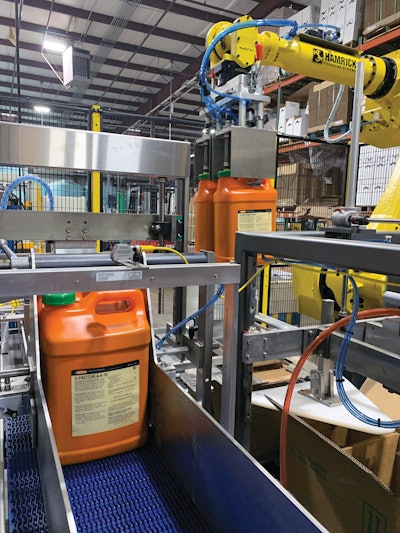
Floratine Products Group of Colllierville, Tenn., is a leading producer of biostimulants used for many years as fertilizers for golf courses and other sports turfs. But management realized that its products are just as suitable throughout most categories of agriculture as they are for fairways and putting greens, so they made a concerted effort to broaden the firm’s marketing message in an effort to expand beyond their previous niche market. That resulted in an increase in demand, which in turn made automated packaging operations more appealing than ever.
Targeted first for automation was case packing and palletizing of extrusion blown HDPE bottles. In the past, the 21⁄2-gal filled bottles were placed into triple-wall corrugated reshippers with center dividers by an operator who used a vacuum-assist device to lift and insert the 20- to 35-lb bottles. Not only was this slow and inefficient, it was difficult to avoid damaging the reshippers due to the heavy weight of the bottles being handled. As for palletizing, it was strictly a manual operation. Mechanical end effectors include two pneumatically driven clamps to mechanically close on the containers and help minimize excessive swaying.
Mechanical end effectors include two pneumatically driven clamps to mechanically close on the containers and help minimize excessive swaying.
Now the case packing is done on a system from Hamrick that relies on an M-710iC robot from Fanuc. Rockwell controls include a CompactLogix controller, Powerflex 525 drives, and Panelview HMI. And palletizing is done on a low-level-infeed palletizer from TopTier. According to Director of Operations Justin Eason, throughput has been doubled to 12 cases/min, damaged packaging has been greatly reduced, and because operators could be reassigned elsewhere in the plant, the labor savings will provide a 2.5-year ROI.
Eason says that when the firm began looking to automate case packing, a robotic solution was not necessarily a given. In fact, a drop packer was the original plan. “I went to see a Hamrick drop packer operating at a plant in Louisiana that was handling a 21⁄2-gal bottle similar to ours,” says Eason. “But our products are so packed with nutrients that the specific gravity of our filled bottles is probably twice what it is for the bottles I was watching. I worried that a drop packer just couldn’t stand that violent dropping motion without being structurally or mechanically compromised in short order. So we decided to attend PACK EXPO Las Vegas 2019 to see what our options were. We talked with plenty of machine builders, including Hamrick. And it didn’t take long to see that the robotic action, which gently lowers the heavy bottles two at a time into the reshipper, was going to be the best approach.”
Eason says he was especially concerned about damage to shipments that go to international markets by way of sea containers. “We sell a lot of product overseas,” he explains, “and we can’t afford to have a bottle leak in one of those sea containers. All it takes is one leaker to ruin half a truckload, and once that happens you don’t get those bottles back. You just eat the cost.”
Unchanged in the Floratine operation is the manual removal of bottles from reshippers and infeed of bottles into the filler. Also unchanged, for now at least, is filling, capping, and labeling. Operators remove empty bottles from their reshippers and put the bottles on a conveyor leading to the filler/capper while the reshippers go on a parallel conveyor leading to the Hamrick robotic system.
Infeed to case packer
Filled and capped bottles enter the case packer single file. The bottles get turned 90 degrees by a turning hook so that they are wide side leading when they reach the case packer. Bottles are indexed two at a time into the pick station, and right beside them are the corrugated reshippers in their parallel conveyor. Major and minor flaps are mechanically plowed open and held open throughout the bottle-insertion process. Meanwhile, the Fanuc robot uses its end-of-arm tooling to pick two bottles and place them into a waiting case. A centering frame helps ensure spot-on positioning as bottles enter the case.
Hamrick made the end-of-arm tooling, which uses two pneumatically driven clamps to mechanically close on the container handles for the purpose of lifting the heavy containers. Also making an important contribution to the picking and placing process is a vacuum suction cup on each end-of-arm tool. By closing firmly on the cap, the vacuum cup becomes in effect a second gripper. Not in the sense that it will help lift the heavy bottles, but rather in that it provides a steadying effect.




































